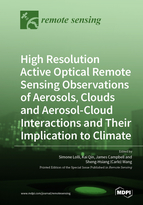High Resolution Active Optical Remote Sensing Observations of Aerosols, Clouds and Aerosol-Cloud Interactions and Their Implication to Climate
A special issue of Remote Sensing (ISSN 2072-4292). This special issue belongs to the section "Atmospheric Remote Sensing".
Deadline for manuscript submissions: closed (29 February 2020) | Viewed by 57157
Special Issue Editors
Interests: radiative transfer; aerosols; lidar; image fusion
Special Issues, Collections and Topics in MDPI journals
Interests: aerosol; trace gases; remote sensing; lidar
Special Issues, Collections and Topics in MDPI journals
Special Issue Information
Dear Colleagues,
This session focuses on new observations of aerosols and clouds events and, eventually, their mute interaction on sub-km, sub-diurnal scales enabled by active optical remote sensing (LiDAR) methodologies. Contributions describing original research results from ground-based, airborne, and space-based observational vantage points are solicited. In particular, geometrical and optical properties of aerosol layers are important in climate, radiation budget, and cloud formation research (aerosol–cloud interaction). One of the goals of this Special Issue is, therefore, to survey the state-of-the-art of active optical remote sensing instruments for determining the vertical and horizontal distribution of clouds and aerosols throughout the atmospheric column. Another topic that benefits greatly from active optical remote sensing instruments is the elucidation of chemical and physical processes that occur in moderately and heavily dust polluted environments. For this application it is necessary to accurately describe the planetary boundary layer dynamics and depth evolution (a field in which LiDAR techniques excel). Other topics of interest for this Special Issue include: process studies related to atmospheric composition, pollution, transport and dynamics, and convective storm development.
The 3th ISPRS Workshop on Remote Sensing and Synergic Analysis on Atmospheric Environment (ISPRS-RSAE) will be held in Nanjing, China during 25-27 October 2019 (http://isprs-2019.csp.escience.cn/dct/page/1), as a continuous event organized by The ISPRS Working Group on Remote Sensing of Atmospheric Environment (ISPRS WG III/8). This Special Issue is also built on the presentations at the 2019 ISPRS-RSAE workshop.
Dr. Simone Lolli
Prof. Dr. Kai Qin
Dr. James Campbell
Assoc. Prof. Sheng-Hsiang (Carlo) Wang
Guest Editors
Manuscript Submission Information
Manuscripts should be submitted online at www.mdpi.com by registering and logging in to this website. Once you are registered, click here to go to the submission form. Manuscripts can be submitted until the deadline. All submissions that pass pre-check are peer-reviewed. Accepted papers will be published continuously in the journal (as soon as accepted) and will be listed together on the special issue website. Research articles, review articles as well as short communications are invited. For planned papers, a title and short abstract (about 100 words) can be sent to the Editorial Office for announcement on this website.
Submitted manuscripts should not have been published previously, nor be under consideration for publication elsewhere (except conference proceedings papers). All manuscripts are thoroughly refereed through a single-blind peer-review process. A guide for authors and other relevant information for submission of manuscripts is available on the Instructions for Authors page. Remote Sensing is an international peer-reviewed open access semimonthly journal published by MDPI.
Please visit the Instructions for Authors page before submitting a manuscript. The Article Processing Charge (APC) for publication in this open access journal is 2700 CHF (Swiss Francs). Submitted papers should be well formatted and use good English. Authors may use MDPI's English editing service prior to publication or during author revisions.
Keywords
- Lidar
- Aerosol-cloud interaction,
- Cirrus clouds
- Aerosols
- Boundary layer
- Air pollution
- Radiative Transfer
- Climate








